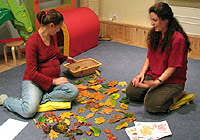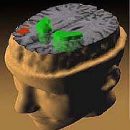Anxiety is a companion of most psychopathological disorders, and covers the widest range of pathology - from severe psychosis to situational reactions familiar from experience almost every person.
Content
Term «panic attacks» Proposed within the framework of the DSM-III-R manual developed on the phenomenological principle. Below are the main diagnostic criteria for panic disorders (F.41.0), according to the international classification of the diseases of the 10th revision:
- The attacks begin suddenly, out of direct connection with specific situations, dangerous and life-threatening situations;
- The panic attack is clearly outlined, it starts suddenly, reaches a maximum for a few minutes and lasts for a few minutes, may be accompanied by states of depersonalization and delay, a sense of suffocation, fear of death or fear of going crazy, heat or cold, sweating, dry skin or tachycardia
-
As a rule, does not correspond to the criteria for other disorders. In the event that the appearance of panic attacks is accompanied by avoiding situations in which the episode of paroxysmal anxiety appeared, panic disorders are described as part of the diagnosis «Agorafobia with panic disorder» (F40.01).
We have developed a program of psychotherapy of affective neurotic-level disorders using the principles and methods of a gestalt approach. She found practical application in the hospital of the psychotherapeutic profile (urban psychiatric hospital number 7 them. Acad. AND.NS.Pavlova G. St. Petersburg) and outpatient practice. Below is a description of the sequence of psychotherapeutic interventions.
Diagnostic Stage
Phenomenological alarms similar in their manifestations of paroxysm (panic attacks) are noted within various nosologies - endogenous disorders of the neurotic and subsischethic level - endogenous depression, neurosis-like schizophrenia, organic and somatic disorders (for example, hypertensive disease and diseases of the thyroid gland) that, accordingly, requires adequate Differential diagnosis. For neurotic disorders, the compliance of the criteria for psychogenies proposed to.Jaspers (1913), the presence of an urgent psychological conflict and its reflection in the experiences of the patient, the severity of the mental and vegetative component of anxiety. For endogenous depressive disorders are more characteristic so-called «symptomatic poor» Panic attacks and presence in one degree or another signs of depressive triad (resistant reduction in mood, motility and thinking slow motion). Panic paroxins in agoraphobia are combined with another important element of the so-called agoraphobic symptom complex - phobic avoidance. Usually patients avoid places that are peculiar «contextual anchors», For the first time emerged anxious-vegetative paroxy - public transport (especially metro station), crowded areas, hypermarkets. They also bear a kind of symbolic burden, acting as an activating situation for various kinds of catastrophic fantasies, reflecting obsessive-compulsive dynamics and a characteristic conflict conflict of self-control. The formation of agoraphobia contributes to a number of personality features of patients whose characteristic of which is the combination of multidirectional trends - expansiveness and a tendency to self-control and self-protection.

In this regard, it seems the useful multi-axis diagnosis of paroxysmal alarm disorders based on the principles of biopsychosocial (holistic) approach (TH. UEXKULL and W. Wesiak, 1991).
In this regard, the psychotherapeutic diagnosis may include several consecutive blocks:
- Actually nosological diagnosis - assessment of the disorder from the positions of the ICD-10;
- The etiopathogenetic diagnosis - within the framework of which disease is considered by an episodic paroxysmal alarm syndrome? What type of comorbidity takes place in this case?
- What is the psychogenesis of the disorder - which acts as a determining, predisposing and starting factor of disorder?
- Psychodynamic Axis - which sustainable personal characteristics of the patient are reflected in the clinical picture of the disorder? What relevant psychological conflicts symbolizes the symptom?
- The existential axis - as disorder reflects a violation of significant relationships in this? What is the context of the situation, directly preceding it? What social medium conditions contribute to its preservation and strengthening (secondary benefits)? Accordingly, the psychotherapeutic diagnosis is like «Rolled treatment plan» is not a static structure, but dynamically changes and refined in the process of relationships with the patient.
Formation of the Alliance
Diagnostics is carried out during the first meeting, according to the results of which the patient may be offered a treatment plan, including the pathogenetic pharmaco - and psychotherapy. Of great importance is the establishment of trusting relationships, with a clear understanding of the patient of therapeutic targets and tasks, on the solution of the pregnant methods. Pathogenetic pharmacotherapy of alarming disorders is carried out using selective serotonergic antidepressants sufficiently long, and the portability of side effects has a priority value. Some patients with alarming-phobic disorders are inherent in the scent of the sickness of the inner painting, which is manifested, above all, the tendency to an even deeper displacement of the psychological conflict for somatic level by increasing protective alexitimia mechanisms. In this regard, the next stage of work is interventions aimed at disclosing the inner picture of the disease and the inner picture of health, which are aimed at the formation and strengthening of informed cooperation and therapeutic alliance. In the Gestalt approach, for this purpose, exercises are used at the introductory stage of therapy, to identify with a symptom - allowing to disclose its symbolic importance and transfer the problem from the purely somatic plane to the plane of the disturbed system of relations. In the state of light relaxation, the patient is proposed to reproduce the symptom as if he manifested itself in the present time, noting all the sensations in the body that arise at the same time. Then patients are invited to choose the image or metaphor of the symptom - for what he could be like, as if moving and.T.D. Next, the patient is offered to voice himself with the symptom - what would he say, turning to «Conscious Ya» Patient? As if symptom «could describe» what he does with the patient? Whatever symptom «said» relatives and close patient? How their behavior changes when it appears?
Working with art-therapeutic and psychodraumatic metaphor also allows you to overcome the conscious resistance of patients and simplify confrontation with the content of the conflict. Identifying with a symptom, as a psychological conflict descended in the scope of the somatic content, the patient with minimal psychotherapist intervention is aware of and accepts psychotherapy tasks.
After discussing the exercise with the patient, a psychotherapeutic contract is concluded, the content of which is becoming regularity, place and time of meetings, role positions of the therapist and client, the conditions for transferring meetings and the completion of therapy. Attention to the conditions of the setting allows you to prevent the consequences of the avoiding behavior of the patient (postponing and cancellation of meetings), stabilize the alliance in the event of a negative transfer (when the therapist is perceived as not sufficient and supportive). Conditions of patient phone calls are discussed separately. Some patients with panic disorder tend to abuse the attention of the therapist, forming a psychological dependence on it, and requiring consolation psychotherapeutic «strokes» Under the conditions of approaching the attack of panic. Such a behavior of the therapist supports the regressive-dependent position of the patient, determining its ability to search for active ways of consolation with anxiety, supporting his understanding of itself as helpless. It seems more useful to consider the patient with simple behavioral techniques, alarm consistent with paroxysm (to their number it is possible to include paradoxical intention, desensitization and.T.D.). Then the patient is given an idea of the nature of anxiety, its vegetative and mental component and is given an explanation: «If with a vegetative, physiological component will gradually cope with medicines, mental anxiety - your emotions, thoughts and fantasies will be the subject of our joint research».
Stage of focused work
The content of this stage of the work becomes a joint in-depth study of the phenomenology of paroxy in a dialogue with the therapist. The study of the context of the occurrence of specific paroxysm is carried out in traditional for gestalt therapy, the key - the patient is offered to reproduce its experiences during the last Panic attack during the last. Most patients voiced so-called catastrophic fantasies, the appearance of which is preceded by the vegetative manifestations of paroxy. In Gestalt therapy, phobias applies to them, which one of the founders of the Izador Fromm method used in working with dreams. Brief formulation of principle - «To decipher a nightmare, it needs to be watching it to the end».
The following session fragment illustrates the elaboration of catastrophic fantasies.
Therapist: Why do you want to start today?
Customer: I sit here on the group, listening to the stories of others and understand that all people have serious problems here, and I always think about this nonsense
(an attempt to devalue its experiences and check the therapist reaction, declared self-evidence)
Therapist: What do you mean mind? Tell us more details…

Customer: I'm afraid of the subway… And of course, I would like to get rid of it, but I don't know, although I understand that the problem is stupid…Maybe you will advise how you can cope with it, inspire me that it is not…
(The client demonstrates a fairly typical request for a mechanical change of symptom formulated enough abstract, requests intro formation «Council» and trying to devalue worrying experiences).
Therapist: Try to tell how exactly you «Afraid of metro»? Imagine that you are already there and tell us about it from the first person and in the present time.
(Therapist encourages self-excloration client, the proposal of the story in the present time is activating the experience and contributes to the mobilization of the client's energy).
Customer: I'm starting to approach the door, I descend on the escalator, I will have an excitement, my shoulders strad up, everything around as if it hangs and starts putting on me, I'm scared, I am afraid, I am afraid that I will lose consciousness and fall down…(Fantasy about falling reflects the fear of losing control and neurotic supercontrol of behavior).
Therapist: Try to imagine what will happen next…
(principle of continuing fancy, «Seeing nightmare»).
Customer: What is the point next? (tense, breathing superficial, is alarming, signs of avoidance in the situation here and now)
Therapist: I note that you have strengthened the strain in the shoulder area, and you have almost pulled to breathe…I suggest to dream, what will happen if you fall…(reflection of the process, saturation of the figure through the background reflection, confrontation with avoidable experience in the form of a preliminary catastrophic fantasy)
Client: (After some pause, a more quiet voice and at a slow pace), I fall down, rushing on the steps past people who are practically no case to me, stretching down and lay on the steps, and people are indifferent to pass by…(Focusing figures)
Therapist: People are indifferent pass by, and they have no matter before me… (saturation of the shape through the reflection of the words of the client). Try to continue fantasy.
Client (after pause) I am without consciousness, people indifferently look at me, someone probably thinks that I am drunk, someone laughs, but most do not pay attention at all, they have their own business - they have no case to some kind Files in the subway (elements of a repeating figure reflecting the frustrated need for)
Therapist: What do you feel now, uttering these words? (Direct appeal to sensory experience «Here and now»)
Client (sighing): sadness and sadness, which helplessness…
Therapist: Stay with this experience.…What it looks like in your life?
(Shule from fantasy to the experience of relationships)
Catastrophic fantasies are mental equivalents of the so-called signal alarm, first described since.Freud - anxiety associated with the penetration into consciousness of the displaced conflict impulse. Mental alarm in the structure of anxiety paroxysm symbolically contains a compromise between the vassed pulse and the protection system against this impulse. When the therapist comes to emotion underlying «Figures» sessions, it makes the so-called shuttle in current relations and life situation - «what it can be in your life?». «Shuttle» can bring the client from catastrophic fantasies to real emotional experience - traumatic memories of the past, or the experiences of this.
Patient A.,34 years old. In the process of studying catastrophic fantasies, imagined the scene of his death from heart attack driving a car. Fantasy about death moments included memories of children, «whose faces are before our eyes», and a sharp feeling of guilt in front of them. For A. The situation was the situation of the conflict adulter, the presence of which he hid from his spouse over the past one and a half years. Over the past year, he began to show alarming-vegetative paroxy.
The content of catastrophic fantasies can be conditionally grouped into partially intersecting blocks reflecting the most frequent conflict zones of patients with panic disorders:
- Catastrophic fantasies reflecting separation alarm. In these fantasies, customers report feeling helplessness, fear to be without support. This fantasy group is characteristic of the personalities of excessively using regressive dependence mechanisms for the purpose of adaptation to the situation. In the structure of catastrophic fantasies of this block, hypochondriac phobias are often found, in particular, cardiophobia - the fear of being among people in helpless state, «with pain in the heart and with foam at the mouth». AND.Yalo highlights as one of the existential protection against the experience of the limb of being «The illusion of the final savior». Ultraized use of this protection in affiliates, as well as frustration needs dependent on vividly in catastrophic fantasy «helplessness». Sometimes unconscious desires for the destruction of meaningful relations (for example, married), under the influence of dangerous to maintain sexual impulses, are contrary to the desirability of maintaining a regressive-dependent role (martyr, victims). Such conflicts are characteristic of historium and masochistic personalities, which may require research mechanisms «Secondary Profit». Characterized by the patient's fluctuations between rage aimed at gaping aggravating communication, and silent humble situation. Duality and contradiability in an attempt to separate on the one hand, and an attempt to preserve the relationship on the other hand can reflect the pathological family context of patients. Cooling relationships with poorly realized borders are moving from the parent family of the patient into his marital relationship and serve as a constant source of intramearily voltage. Department and autonomy, being a necessary part of a vital process, experienced patients as irreversible loss. The origins of such duality can be sought in the ambivalent position of the parents in relation to the attempts of separation from the child.
- Catastrophic fantasies reflecting the inconsistency of mechanisms for controlling emotional expression. In this case, in the structure of catastrophic fantasies, fear dominates unconventional behavior. From the hypochondriah phobias in this block dominates Lisofobiya (fear of madness). Lisopobia is also often found in the structure of agoraphobic symptom complex in the initial period of low-armred schizophrenia, but in this case it is distinguished by the non-differentiation of the description and is combined with a number of other pathogenic disorders: the spheres of thinking, self-consciousness, the emotional-volitional sphere, the perception of bodily functions. In the course of the study of the Lisofobic fantasies, the gestalt approach to the patient is invited to identify «Mad part» and also voice your experiences in this role, completely losing her psychodermatically or in imagination. In the case of neurotic etiology of fantasy disorder «Madness» contain elements of guilt and shame for their behavior that indicate the blocked expression of affects associated with destructive aggression. Thus, the main content of the psychoshenic conflict is revealed between the debt (by the intrinsic expression norms) and the desire (aggressive impulses aimed at ensuring the autonomy of behavior). In the further dialogue with the patient in focus of attention, there are mechanisms for controlling emotional expression (retroflex), as well as mechanisms for coercion and normativeness of behavior (intractions). Introductive regulativity is built on a clear compliance with the Communication Rules, the violation of which can cause a sharp sense of shame (a compulsive desire appears to leave the room for negotiations, the fear of look ridiculous due to excitement). The experiencing of the shame is also associated with the projection of self-conjugation and previously occurring traumatic experience of his own insolvency, public humiliation, which others could observe. So shame is «triad permanent», in which the humiliation is risking to be excluded from the group in connection with the decline in its rank in the social hierarchy (equivalent «Exile from the tribe»). Another significant aspect of shame is its retroflexic (retroflex - turn against itself, the return of the impulse). In shame connects «The desire to disclose and be accepted with all its shortcomings, and the desire to hide their weaknesses and defects». As a result, the desire to hide and the experience of inferiority increases. The subject of dependence is also reflected in fantasies about madness - free from the tyranny of coercion in relationships, you can only «Sowing with Mozh». Any fantasy, according to the psychodynamic tradition, is the realization of the possibility of either the desire, disagreeing with the goals «Conscious Ya». «Crazy part» Spriocted in fantasies about the loss of control, first of all, is delivered from liability and tight following conventional behavioral standards. It is not by chance in the folk tradition of the jester or blessed could tell the despot in the face, everything about what they think, but do not say others. In the therapy of sociophobic experiences, group forms of work are more effective, in which corrective emotional experience and positive feedback of participants of the group can be obtained- «Thirdians». These are also created conditions that facilitate subsequent self-dissection in social interactions.
- Catastrophic fantasies associated with the inconsistency of avoidance mechanisms. In the structure of fantasies of this block, fantasies are dominated by fantasies associated with hopelessness-claustrophobic and tanatophobic experiences (fear of death, fear of being closed in the elevator, the fear of interventions related to immobilization - for example, in the dentist's office). Death is the most vivid existential symbol of the border, and Tanatophobia is a tangible manifestation of existential anxiety. Compulsive delay of activity related to the possible risk, characteristic of obsessive, perfectionist and avoiding personalities is «Pompe», constantly pulling tension and anxiety. The result of which is a large number «Chronically unfinished gestaltov», displaced blurry of existential landmarks and the uncertainty of personal boundaries. The displacement mechanism plays a key role in the formation of phobias and one of the first protective mechanisms, described.Freud in his analysis of the phobia of Little Hans. Its analogue in the gestalt approach is a mechanism for deflexing (evasion), including both the traditional analytical understanding of the displacement of both the process of acting in perception and the underlying avoiding behavior. Deflex is fixed under risk conditions of too turbulent and painful reaction of a significant other on manifestation of personal autonomy. Too critical attitude to child errors, overestimated standards of performance, stormy displaced aggressive affects of parents are an incomplete list of conditions that contribute to the formation of creative adaptation «Deflexia». As a result of excessive use of this mechanism formed «layout syndrome», Promotional voltage growth. Internal response tension enhances passive protection mechanisms, in particular, the mechanisms of denial and reactive education, as well as «Destruction made».
Strengthening these mechanisms, as a rule, directly reflects the availability of current protracted interpersonal conflict, difficulties in building boundaries and pathological adaptation to disturbed relations.

For example, the more hidden aggression and tension of the relationship between spouses, the more polite-warning becomes the behavior of the patient regarding the dependent spouse («Reactive education»). However, the boundaries of the dependent partner remain disturbed and periodically arise a compulsive rage breakthroughs in relations with the subsequent increase in the feeling of guilt. The intolerance of guilt causes attempts to reconcile with the spouse through the refusal of claims and return to the dependent relationship («Destruction made»).
Tanatophobia in this context is an existential signal reflecting the need to summarize and establish more specific personal boundaries, the death of social facades and manifestations of its true essence. F.WITH. Perlz in his metaphor «Layers of neurosis» highlighted «layer of death», The passage of which is necessary for authentic changes in the existential situation. The death of one sustainable, but outdated configuration of the system of relationships leads to the inevitable birth of a new one and is a constant element of the process of self-actualization. However, it is associated with inevitable losses and risks, and is fraught with revitalization of earlier alarms associated with separation from the object of affection. Sometimes in the process of studying catastrophic fantasies, customers perform spontaneous «Chelovela» In traumatic experiments of early childhood separation.
Patient E.IN. «I remember the case of early childhood when Dad brought me to a sanatorium for children suffering from breathing diseases. Before that, I never left and left alone. I could not understand for a long time where he left, he said something about what he would come back soon. The children met me ridicule, I did not know what to do and fell asleep on my bed to wait for him as soon as… When I woke up and tried to open my eyes, and I discovered with horror that I could not do it. I started shouting from horror, and tried to blame the eyelids with my hands - they were glued with something solid… Then I heard all the children in the ward laugh at me - it turned out, they got my eyes to the toothpaste…This feeling is very similar to what I feel in the elevator or in the metro car now…».
Exploring traumatic memories, Gestalt therapist proceeds from the fact that the appearance of such memories in the present is inevitably connected with the actual situation - the microcontext field, «Client-therapeut» and macrocontext «Personality situation». Thus, the study of the material of catastrophic fantasies can be the starting point of the psychotherapeutic process, the purpose of which is to identify and resolve the psychological conflict by awareness of the deadaptive role of protective mechanisms in the actual existential situation of the patient.
Completion of therapy
One of the most important tasks of the therapist is the growth of personal autonomy of the patient, increasing the degree of awareness of mental processes (protection and mechanisms of consolation with stress) in relation to the actual situation. The patient is offered «Loose» Various contexts of relationships in which avoiding behavior is manifested, striving for a more complete expression of oneself in contact with others. In the course of successful therapy, the patient partially intervalizes the process-oriented issues in the internal dialogue, increases «observing ego» and thereby increases the degree of differentiation of emotions and personal integration. Faced with the experience of anxiety, the patient itself formulates the so-called «Process - Oriented Questions» and comes to the awareness of pathogenetic mechanisms of neurosis. Often it is accompanied by the need for a painful restructuring of the system of relations, in which the role of the therapist is becoming increasingly supportive, intervention is predominantly self-supporting, the need for confrontation and disclosing interventions is reduced. Installed bridge awareness «Symptom Emotion-Situation» helps to reduce vegetative alarm and gradual desmate









